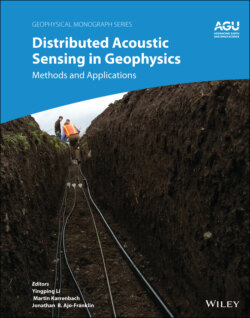Читать книгу Distributed Acoustic Sensing in Geophysics - Группа авторов - Страница 59
3.2.2. Concept and Characteristics of DMOF
ОглавлениеTo enhance the SNR of the sensing signal light and ensure low transmission loss within the optical fiber, we propose a special sensing fiber named as DMOF for DAS. The design schematic of the sensing fiber is shown in Figure 3.2, which introduces successive microstructures with refractive index modulations in the fiber core through UV laser light exposure. The microstructures can be treated as small and strong scatters and distributed along the optical fiber with the same interval. Ultraweak fiber Bragg grating (UWFBG) inscribed on the fiber is one type of microstructure that has been recently employed to enhance the SNR for fiber optic DAS (Ai et al., 2017; Zhu et al., 2015). However, the spectra of UWFBG will shift with temperature and strain change (Yang et al., 2016), and consequently the uniformity of the SNR enhancing effect along the optical fiber is difficult to control. To overcome the effect of environmental change along the optical fiber, Rayleigh backscatters with only an increase in the SNR, but colorless, are desirable, which can be created by continuous UV laser light exposure alone without periodic refractive index modulation.
Figure 3.2 Schematic of DMOF.
Then, the stabilization effect of DMOF is systematically investigated through numerical simulation. To analyze the influence of the scattering light amplitude on the intensity distribution along the fiber, one microstructure is assumed to be inserted at the center of a 2‐m‐long SMF corresponding to the injected pulse width of 20 ns, serving as a stronger scatter. Random temperature fluctuation or strain effect is applied on the fiber section, resulting in the random phase change. When the intensity of the backscattering light from the microstructure is set to 0 dB, 3 dB, 7 dB, and 10 dB higher than the intensity from the SMF without microstructures, the dynamic intensity distributions around the scatter over 1,000 traces appear to be more and more stable, which are shown in Figures 3.3a–3d, respectively. Figure 3.3a shows that, when the scatter is weak, the intensity at any position is not stable, and the fading points along the fiber randomly move for different traces, which is a fatal defect for low‐frequency acoustic sensing. The intensity distribution, especially the intensity at the scatter marked by the black dotted line, becomes more stable and grows stronger with the enhancement degree of the scatter. Hence, the intensity fading is gradually eliminated, and the SNR and long‐term stability are improved step by step.
